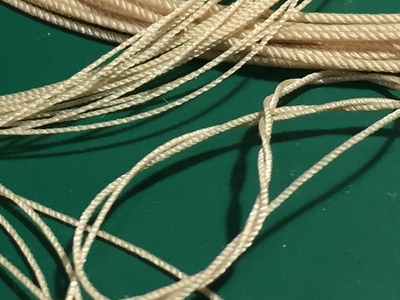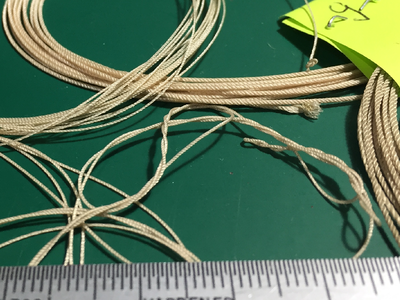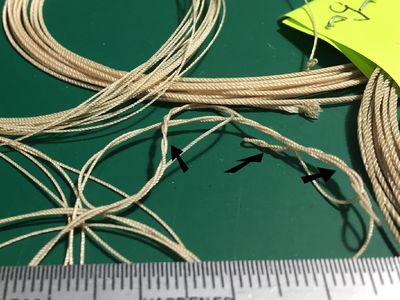Much time has been put into making ropes (and it's a worry when you find yourself seizing the ties on your tomato plants). Over-all I'm usually happy with my rope results but what is baffling me is why do they keep twisting into themselves when being worked into some rigging. I watched Olha video and her ropes behave, in my opinion wonderfully, no twisting, twirling or knotting into themselves. My rope making follows Steef66 excellent instructions and threads used are Serafil/Gutermann. - Thread lengths reduction on the ropewalk 8%-10% before starting the actual rope turning. 15% for thicker rope. End results are Baked @ 177c (approx) for 5- 5.1half minutes (depending). So in theory, bearing in mind my inexperience, I should be making good rope. But the thinner the rope the more pronounced this twisting issue which is very annoying and a bit soul destroying. So my question is; Why is this happening, what is not being done correctly, is there a solution, how can I overcome this irritating little problem? - is this happening other DIY rope makers and is it perhaps somewhat acceptable??? Here's hoping this isn't a silly query - Cheers.
You are using an out of date browser. It may not display this or other websites correctly.
You should upgrade or use an alternative browser.
You should upgrade or use an alternative browser.
It's a great question. The reason why the ropes are twisting up has to do with how the rope was laid, and I assume if has something to do with the tightness of the twist. If the individual strands twisted differently than the twist of the rope using those strands, then there is in an imbalance of tensions within the rope. Those with a rope walk can explain it in more detail. More experimentation with your rope walk may be necessary to get the ropes coming out better.
I think @dockattner (Paul) is the more recent member to learn the skill of ropemaking with a rope walk. I'm sure he could help you.
I think @dockattner (Paul) is the more recent member to learn the skill of ropemaking with a rope walk. I'm sure he could help you.
Last edited:
If they are polyester, you can cure them in an oven. I wrap the rope around an old toilet paper roll and put it in a 300f toaster over for 5 minutes. It behaves quite nicely after that. (as would I  )
)
Test a little bit first to check your ovens temp.
Test a little bit first to check your ovens temp.
Thank you very much for replying. I think I have the twisting directions correct because if the twist is reversed the rope snaps at the halfway point sounding like a big twang. Perhaps you have a point that the twist tension could be too tight, this will have to be checked out over the next couple of days. Also, I do look forward to Paul's input and advice. cheers.It's a great question. The reason why the ropes are twisting up has to do with how the rope was laid, and I assume if has something to do with the tightness of the twist. If the individual strands twisted differently than the twist of the rope using those strands, then there is in an imbalance of tensions within the rope. Those with a rope walk can explain it in more detail. More experimentation with your rope walk may be necessary to get the ropes coming out better.
I think @dockattner (Paul) is the more recent member to learn the skill of ropemaking with a rope walk. I'm sure he could help you.
Hi Don, yes all are polyester although I have tried a couple of reels of cotton thread. In this case I refer only to the polyester. The rope when made is wrapped around used tin cans and baked in an over for 5min @ 177celsius (350.6f) temperature wise I have a portable Salter temperature gauge as well as the oven gauge. In comparison they read +/- by 2-3 degrees of each other. Interesting you use old toilet rolls something that I need to try soon. Very good to know you behave quite nicely after a good bakeIf they are polyester, you can cure them in an oven. I wrap the rope around an old toilet paper roll and put it in a 300f toaster over for 5 minutes. It behaves quite nicely after that. (as would I)
Test a little bit first to check your ovens temp.
Do you have a picture of what is happening? I can't quite picture what you are describing. And maybe a macro image of your completed rope.
Your technique reads correctly (though I also gently stretch my just-made ropes a bit before wrapping them around the can and baking them) - especially if I am using a tighter twist on my thinnest ropes.
Your technique reads correctly (though I also gently stretch my just-made ropes a bit before wrapping them around the can and baking them) - especially if I am using a tighter twist on my thinnest ropes.
Hi Paul, thank you for responding. Three images of the same photo taken with iphone6. Thin Ropes (2x2) are Serafil 180tex 16 and the thicker rope is Gutermann 80 (32x2). Not the best quality or sharpness but hopefully they are indicative of my finished ropes and the twisting that's irritating me. This twisting emphasises itself when tying knots or threading blocks. Seizing! well that's a case for quadruple espressos'. I took more pics but they just looked like blurry birdsnests. The only thing I don't do is stretch before baking and I can't visualise the process. Hope you are able to help. Cheers.Do you have a picture of what is happening? I can't quite picture what you are describing. And maybe a macro image of your completed rope.
Your technique reads correctly (though I also gently stretch my just-made ropes a bit before wrapping them around the can and baking them) - especially if I am using a tighter twist on my thinnest ropes.



One observation and one question:
Observation: that twist is REALLY tight.
Question: what do you mean by 2x2 and 32x2? Are you only spinning 2 source threads into the rope? I know Steff66 does that for his smallest ropes, but I wasn't able to make that work in my hands (IT GOT ALL TWISTED!!!). All of my ropes use three source threads (though that might mean two, three, four, five, six pieces of string per 'source thread'. But there are always three source threads that then get twisted (3x1, 3x2, 3x3, 3x4, 3x5, etc.).
Observation: that twist is REALLY tight.
Question: what do you mean by 2x2 and 32x2? Are you only spinning 2 source threads into the rope? I know Steff66 does that for his smallest ropes, but I wasn't able to make that work in my hands (IT GOT ALL TWISTED!!!). All of my ropes use three source threads (though that might mean two, three, four, five, six pieces of string per 'source thread'. But there are always three source threads that then get twisted (3x1, 3x2, 3x3, 3x4, 3x5, etc.).
Having made rope skeins for medieval crossbows, I can tell you that stretching the rope after you take it off the rope walk is very important. If you don't, there will be sections of the line with tighter twist than others, and uneven distribution of the internal twists of the strands relative to the rope as a whole. Stretching evens out uneven forces which can cause coiling considerably. Take the ropes you have now and stretch them, not in sections, but from in one stretch from one bitter end to the other. The apply the heat treatment to loosen remaining high tension spots.
(2x2) yes 2 source threads into the rope its the only way I've managed thin ropes. The other is 3x2. It never occurred to me to try 3x1 Still so much to learn and experiment with. So the twist is too tight? that's worth taking into account and adjusting the weight. Back to playing with the Rope Walk. Thank you for this.. cheersOne observation and one question:
Observation: that twist is REALLY tight.
Question: what do you mean by 2x2 and 32x2? Are you only spinning 2 source threads into the rope? I know Steff66 does that for his smallest ropes, but I wasn't able to make that work in my hands (IT GOT ALL TWISTED!!!). All of my ropes use three source threads (though that might mean two, three, four, five, six pieces of string per 'source thread'. But there are always three source threads that then get twisted (3x1, 3x2, 3x3, 3x4, 3x5, etc.).
that's an eye opener and you are correct. I have noticed many times variations and unevenness in some of my ropes. This is excellent guidance from both you and Paul. It's no wonder I thoroughly enjoy SOS.... CheersHaving made rope skeins for medieval crossbows, I can tell you that stretching the rope after you take it off the rope walk is very important. If you don't, there will be sections of the line with tighter twist than others, and uneven distribution of the internal twists of the strands relative to the rope as a whole. Stretching evens out uneven forces which can cause coiling considerably. Take the ropes you have now and stretch them, not in sections, but from in one stretch from one bitter end to the other. The apply the heat treatment to loosen remaining high tension spots.
Once you use three source threads the rope won't look so tightly twisted. I would still use 15% for your lighter ropes and 10% for the heavier ones (and on a sliding scale in-between). Just takes practice.(2x2) yes 2 source threads into the rope its the only way I've managed thin ropes. The other is 3x2. It never occurred to me to try 3x1 Still so much to learn and experiment with. So the twist is too tight? that's worth taking into account and adjusting the weight. Back to playing with the Rope Walk. Thank you for this.. cheers
The 3x1 may not look great unless you make it left-handed (S twist) since your source threads are right-handed (Z-twist). The solution (if you want right-handed thin ropes) is to untwist the source threads (the weight will actually drop as the threads get longer and turn them into left-handed thread), and then use those left-handed threads to make thin right-hand rope.
More good advise. This is all very much appreciated (unbelievable but I know Z & S twist from past posts and by the fact I have two hands). To start with I'll go with Kurt's suggestion and take the existing ropes, stretch them and re-bake and see what happens. The next lot of ropes will be as per your suggestions and guidance in this post. So much to play and experiment with. Thank you very again this has been like an early Christmas present. Cheers.Once you use three source threads the rope won't look so tightly twisted. I would still use 15% for your lighter ropes and 10% for the heavier ones (and on a sliding scale in-between). Just takes practice.
The 3x1 may not look great unless you make it left-handed (S twist) since your source threads are right-handed (Z-twist). The solution (if you want right-handed thin ropes) is to untwist the source threads (the weight will actually drop as the threads get longer and turn them into left-handed thread), and then use those left-handed threads to make thin right-hand rope.
- Joined
- Jul 27, 2021
- Messages
- 213
- Points
- 253

There is no need to stretch polyester rope, there is also no need to rebake it. Your rope is just "overlayed [guess that is the wrong word  ]" so you have too much twist in it.
]" so you have too much twist in it.
Check this little Video here: https://www.dubz-modelling-world.com/uploads/big/3c850c08602474cc1829232ecedd0572.MP4
That is what I do to get the overlayed energy out of the rope.
Dirk
Check this little Video here: https://www.dubz-modelling-world.com/uploads/big/3c850c08602474cc1829232ecedd0572.MP4
That is what I do to get the overlayed energy out of the rope.
Dirk
So just let it unwind a bit? Sounds too easy.There is no need to stretch polyester rope, there is also no need to rebake it. Your rope is just "overlayed [guess that is the wrong word]" so you have too much twist in it.
Check this little Video here: https://www.dubz-modelling-world.com/uploads/big/3c850c08602474cc1829232ecedd0572.MP4
That is what I do to get the overlayed energy out of the rope.
Dirk
I hang mine by one end so all the (excess) twist can come out. That may be a problem with a continuous walk where you can make 10meters or more.
- Joined
- Jul 27, 2021
- Messages
- 213
- Points
- 253

So just let it unwind a bit? Sounds too easy.
In a rope, the forces must be in balance, i.e. the forces from the twisting of the single (or multiple) strands that are then lay into a rope. When the rope unwinds it was not in perfect balance
It unwinds until the two forces are in balance. As long as it looks (is) right when it untwists you are golden.
Cool video. I'll try that this coming weekend. Thank you very much.There is no need to stretch polyester rope, there is also no need to rebake it. Your rope is just "overlayed [guess that is the wrong word]" so you have too much twist in it.
Check this little Video here: https://www.dubz-modelling-world.com/uploads/big/3c850c08602474cc1829232ecedd0572.MP4
That is what I do to get the overlayed energy out of the rope.
Dirk





